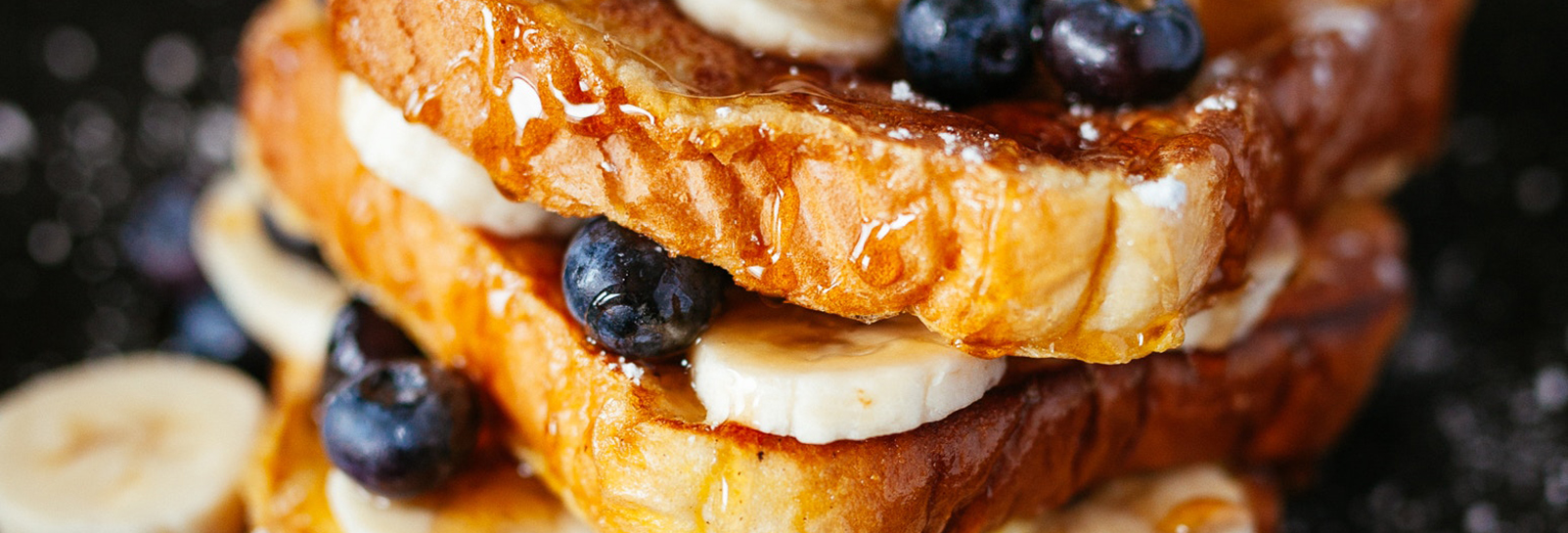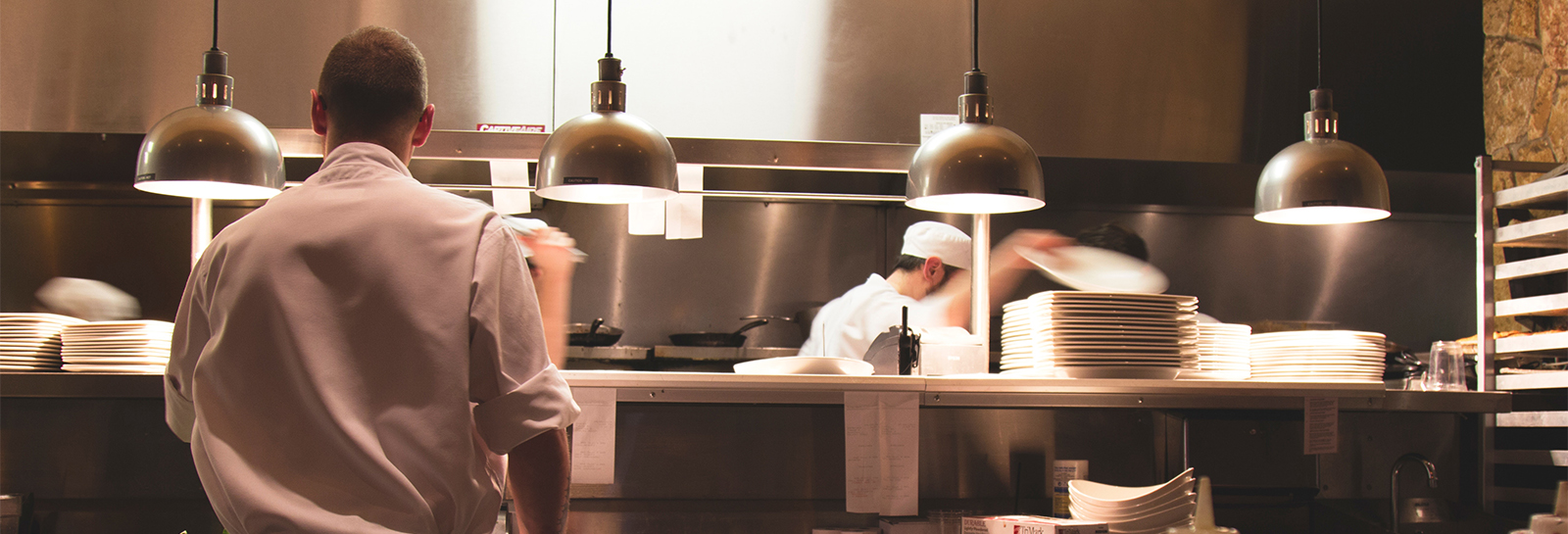Thought for Food: Ingredients for a Winning B2B Food Marketing Strategy

Share this story
Industry know-how and audience-first strategy are ingredients for success in B2B food-service content marketing.
When’s the last time you looked at a picture of food? Unless you’re on a digital cleanse (in which case, more power to you), it was probably in the last 24 hours. Whether you consider yourself part of the food-culture movement or not, the media supporting it—from the late Anthony Bourdain’s Parts Unknown to #foodporn on Instagram—make it impossible to escape.
Greater exposure to global cuisines, evolving perceptions of health and a deep hunger for memorable food moments have created a generation of highly educated and vocal diners who are choosier than ever. That means food pros and restaurant brands are serving a clientele that’s increasingly knowledgable about flavors and cooking techniques and interested in their food’s back story. Once behind-the-scenes work is now taking center stage, from ingredient sourcing to labor practices to plating.
The stakes have been raised. Operators—chefs, restaurateurs, culinary directors, general managers and others—have to stay ahead (or at least keep pace) with this food movement. They need deep insights into who they’re feeding as well as creative inspiration to get their own brand messaging noticed.
And as part of an industry with notoriously thin margins, foodservice pros need to sharpen their restaurant management and business smarts, too.
Enter leading food industry suppliers, distributors and vendors, who welcome the opportunity. Just over one-third of B2B restaurant and food brands use content marketing, and 24 percent planned to increase their investment in content marketing in 2018, according to a report from Informa Engage.
Attractive, relevant and actionable content educates and inspires their audiences, fuels their own products’ success and ultimately nurtures long-term customer relationships. But in such a saturated food media landscape, how does B2B food content consistently offer value and stand out? We talked to three foodservice brands creating quality experiences with their recipes for content marketing success.
B2B food marketing 101: How to strategize like a pro
Getting in front of restaurant pros requires more than artful, well-lit food shots. You need in-the-trenches kitchen smarts, a strong pulse on the industry and publishing know-how. Learn how with these content marketing tips by Sterling, Virginia-based Cuisine Solutions, a premium foodservice supplier that specializes in sous-vide preparation:
1. Establish yourself as a leading content authority
At the crux of its strategy is Sous-Vide, a sophisticated biannual culinary magazine aimed at demonstrating Cuisine Solutions’ internal expertise and demystifying the sous-vide process—a cooking method reserved for high-end dining, sous vide (in which food is vacuum-sealed in plastic and submerged in temperature-controlled water) is now in Starbucks pastry cases and on Williams-Sonoma shelves.
In addition to ingredients and food preparation, Sous-Vide profiles innovative chefs and explores dining trends and destinations, as well as lifestyle topics like travel, gift ideas and misinformation about sous vide.
Prophet’s team has found success leveraging the print magazine at trade shows, university campus demos and events like Maker Faire, attracting creative artisans of all types.
“[The magazine] creates open lines of communication and more engaging topics of conversation when we have meetings with clients,” says Jennifer Prophet Cabriales, Cuisine Solutions’ former director of marketing.
Today, Sous-Vide is available as a digital-only publication, but the magazine’s mission remains the same.
2. Create a precise content plan
The magazine’s parameters are strict, which amplifies Cuisine Solutions’ thought leadership and allows it to dominate its niche. “Every article that we’ve put in the magazine has to focus on sous vide in some way,” says Michelle Thomas, managing editor of Sous-Vide magazine. “That includes the interviews with the chefs—talking about how they use sous vide—to when we did a roundup of the trendy food halls, looking at how food vendors are using sous vide in that context, and the process stories—really getting a deep dive into how people are using this specific technique. It seems like such a specific niche, but once you get into it, there’s so much content.”
To ensure an exact level of accuracy and best practice in recipes, how-tos and other process-specific pieces, Sous-Vide leverages Cuisine Solutions’ internal expert chefs, many of whom have years of experience in professional kitchens. Some have even earned a Michelin star (or three).
“There’s such a precision to sous vide,” says Gillian Goodman, vice president, senior managing creative director at HZ, Cuisine Solutions’ agency partner. In addition to participating in editorial brainstorms and formulating recipes, these chefs attend magazine photo shoots, ensuring everything from the ingredients to the props to the finished dishes are up to snuff.
3. Don’t leave your audience hungry
While Cuisine Solutions’ primary customers are foodservice operators, the magazine’s team found the growing popularity of the sous-vide technique among home-cook consumers is an opportunity to expand the brand’s reach.
But speaking to different audiences—professional chefs and home cooks of varying skill levels—requires strategic editorial planning. “[We] come up with a nice balance of recipes on all ends of the spectrum: something for the beginners, something for the intermediate cook and something for more advanced cooks,” says Michelle Kabler Svecharny, account director at HZ. “Similarly, in all of the content supporting the recipes—what’s new in the food space, what chefs we’re profiling—we really try to speak to all of those audiences and provide something for each of those groups.”
These diverse audiences also affect how food is styled at shoots. Recipe photos focus on finished dishes presented on simple surfaces or attractive, but not flashy, dishware. “Everything is plated elegantly, but simply. The key is: It’s not about anything else in the picture, it’s just about the food,” Prophet says.
Reaching your audience is central to creating a quality product. But in order to do that, you first have to learn how to speak to your audience. Learn how to create food content foodies and pros will devour with these content marketing do’s and don’ts.
Required restaurant reading: Dig into these B2B marketing food industry examples
For many foodservice pros, fulfillment comes from feeding others and expressing themselves through the culinary arts. But it’s not just cooking-technique content this audience craves. They’re also business people, who, at the end of the day, need to manage staff, advance their careers, deal with HR issues and make ends meet.
Independent chefs and restaurateurs in particular need business advice and insights specific to their unique operations. Check out these three brands doing it right:
Restaurant Insider: Serving industry knowledge
Meeting this need is the goal of Restaurant Insider, an industry blog from Providence, Rhode Island-based restaurant management and point-of-sale software provider Upserve.
“Our typical reader is someone who is trying to do it all themselves, working around the clock, running a family business, having their sister help bus tables,” says Meghan Kavanaugh, a former content marketing manager at restaurant software company Upserve. “If we can help by giving them a marketing strategy or by telling them the hot new menu items that people are going to be looking for, it takes some of the pressure off and helps them execute on a small budget, with small bandwidth.”
The blog lives on Upserve’s main site and exists as a robust content-hub ecosystem, covering restaurant operation topics ranging from seasonal marketing to menu pricing and regulations to beverage trends. The editorial strategy relies heavily on keyword research and measurement; monitoring site traffic and social distribution has uncovered that labor, training and staffing are popular topics with Upserve’s readers, for example.
Restaurant Voices: Dishing up insider intel
This audience demands insider information. Foodservice pros rely heavily on word-of-mouth, which inspired Restaurant Insider’s “Restaurant Voices,” first-person narratives in which owners, chefs and other industry vets share personal stories about culinary inspiration, making difficult business decisions and other restaurant topics. These pieces not only satisfy that need for peer advice but also ensure the authenticity of the storytelling and legitimize the insights.
Alongside these longer-form features are chunkier articles heavy on subheads, pull quotes and images, providing specific, actionable takeaways in a quick-hitting, digestible way. Kavanaugh attributes the success of these pieces to the lifestyle the audience leads: “Something that’s unique about restaurant owners is they don’t have a typical 9 to 5. They’re always moving; they’re always on the go.”
On the go also means formats that are content marketing slam dunks in other B2B industries may fall flat with chefs and owners. When Upserve experimented with webinars, sign-ups were decent, but attendance was low. “When you think about the day-to-day of a restaurant manager or owner, do they really have 45 minutes to stop and watch a webinar?” says Amber van Moessner, Upserve’s senior director of communications. “It works for a lot of unique B2B audiences, but it didn’t work for ours, so we needed to pivot and reassess.”
Upserve recently launched the Restaurant Insider Podcast, a series in which chefs share their experience opening a restaurant. “It’s a really great way to bring the voices of the restaurant owners right to (the audience),” van Moessner says. “A podcast is something they can listen to in the car.” Early results for the podcast are good—nearly 300 downloads—and the content marketing team is excited to explore the format further.
Also on the table for Upserve: a print magazine that repurposes top-performing digital content. “Direct mail and printed materials are something we’re experimenting with because it may not be acceptable as a restaurant manager to be on your phone even if the restaurant’s slow, but it is more socially acceptable to flip through a magazine or a piece of mail,” van Moessner says.
Upserve recently launched the Restaurant Insider Podcast, a series in which chefs share their experience opening a restaurant. “It’s a really great way to bring the voices of the restaurant owners right to (the audience),” van Moessner says. “A podcast is something they can listen to in the car.” Early results for the podcast are good—nearly 300 downloads—and the content marketing team is excited to explore the format further.
Also on the table for Upserve: a print magazine that repurposes top-performing digital content. “Direct mail and printed materials are something we’re experimenting with because it may not be acceptable as a restaurant manager to be on your phone even if the restaurant’s slow, but it is more socially acceptable to flip through a magazine or a piece of mail,” van Moessner says.
Finding new ways to fit into these people’s daily lives, rather than pulling them away from it, is key. “Every company I’ve gone to, the biggest adjustment has been finding what works for that audience,” says van Moessner, who previously held content marketing roles at Vimeo, Livestream, Mic and Newscred. “I would encourage people to think about that before they think of any of the traditional building blocks of strategy or measurement.”
Chef’s Roll: Providing a chef-first content plan
Placing a priority on being where the audience is has drastically evolved the content strategy for Chef’s Roll.
Web developers by trade, Frans van der Lee and Thomas Keslinke created the online community after realizing chefs, cooks and other culinary pros needed a place they could network and flaunt their chops for new job opportunities. Today the site has more than 18,000 members from more than 140 countries.
Content sponsorships from foodservice brands—from ingredient purveyors to dishware companies—created an opportunity for Chef’s Roll to make cinematic, social-first videos featuring chefs across the country. These videos have garnered tens of thousands—in some cases, millions—of views.
Speaking about the Chef’s Roll’s target audience of restaurant pros, van der Lee, who serves as president, says, “They love seeing beautifully plated dishes, interesting ingredients and techniques. And they love meat—meat, fire, knives. They love that stuff.”
For example, last year, Chef’s Roll posted a video on Facebook of fishmonger Tommy Gomes breaking down an opah, a huge saltwater fish known for its gastronomical versatility. As Gomes fillets the fish, his voice-over explains its seven cuts of meat and their applications. The video’s since gone viral: It has 24 million views and has been shared roughly 268,000 times.
“And the fishmonger is now quasi-famous,” van der Lee says.
He attributes the success of Chef’s Roll content to a couple of factors, the first of which is a lack of overt product promotion. About 90 percent of the site’s videos are backed by brands, but Chef’s Roll’s in-house creative team works hard to ensure these align with the site’s mission to inspire and connect chefs.
“We really push back with clients who say, ‘Can you put these points in the voice-over?’ We’ll say, ‘We can hit a few of them, and maybe we’ll add some in the post copy instead,’ or maybe we’ll link to an article featuring the product,” he says. “A lot of them understand—now seeing our results—that it’s better to not be overly commercial and let us do our job of inspiring chefs.”
The opah video was sponsored by knifeware company Wüsthof, and the only hints of the brand are the blade Gomes uses to break down the fish and a logo on the closing screen.
Another tactic that’s central to Chef’s Roll’s content strategy is creating pieces specifically for social.
“Chefs are super busy. When they have time, they’re on Instagram or Facebook,” van der Lee says. “We’ve even found the best way to get in touch with chefs is through Facebook Messenger. Forget email.”
For a partnership with Prosciutto di Parma, Chef’s Roll filmed a chef breaking down a whole bone-in pig leg and then creating four unique dishes with the meat. The team also had photographers capture the process. The end result was a content package of under-2-minute Facebook videos, 30- to 60-second Instagram videos of each dish, and about 90 lifestyle and dish photos for social sharing.
While Facebook is where Chef’s Roll has seen its content go viral, Instagram’s become a primary focus for the networking site. In 2018, that was partially due to Facebook’s algorithm update that gave friends-and-family posts prominence over branded content in news feeds. (Today, the algorithm is all about engagement. The more people engage (save, share, comment, like) the more you’ll be rewarded.)
In addition, the photo-rich platform’s a great way to promote Chef’s Roll members and reinforce the culinary community. Van der Lee’s team regularly reposts pictures from chefs tagged #ChefsRoll or #RollWithUs. These posts earn those pros a significant bump in follower numbers.
“We’ve had chefs email us and thank us for reposting their stuff,” he says. “A couple chefs have printed out the post and put it up on their wall or in their kitchen.”
In an industry with such a tight sense of community and where much of the creativity is driven by emotion, that type of engagement and response is a content marketer’s dream.
Get an extra helping of 5-star culinary content
Use these two best-in-class examples to get your creative juices flowing:
The Dave Chang Show
The gist: David Chang, founder of restaurant empire Momofuku Restaurant Group and creator of Netflix’s critically acclaimed Ugly Delicious, hosts a weekly podcast covering, well, whatever he wants, it seems. This isn’t Chang’s first content rodeo. He co-created Lucky Peach, an edgy food and travel magazine that ran for six years, and Netflix’s critically acclaimed foodie docuseries Ugly Delicious.
Listen for: Unfiltered reflections on running a restaurant, conversations about gender equality and cultural representation in the culinary world, and a lot of parallels between food, sports and TV. Chang’s diverse guest list ranges from teen snowboarding rock star (and Olympic gold medalist) Chloe Kim to filmmaker Rian Johnson to bakery darling and entrepreneur Christina Tosi.
Follow Chang’s lead: The word “authentic” is overused today, but there’s no better way to describe Chang’s style. The show’s a mix of thought catalogs and honest, emotional conversations. We also love the emails from Majordomo Media (Chang’s new entertainment company) that supplement each pod episode with cheat sheets of terms or names from the episode, additional info about the guest and related media recommendations. They dig deeper into Chang’s world and make the reader feel like they’re part of his cool-friend club.
Toothache magazine
The gist: Toothache is “a food magazine for chefs, by chefs.” Unsatisfied with the scarcity of food magazines developed for chefs—rather than home cooks and foodie consumers—San Francisco-based pastry chef Nick Muncy created Toothache. The magazine features high-profile chefs the likes of Albert Adrià (Tickets, Enigma and Pakta in Barcelona), Kim Alter (San Francisco’s Nightbird) and Gabriela Cámara (Cala in San Francisco), who tell their stories through personal essays, Q&As and recipes.
Why grab a copy: A clean, white-space-rich, minimalist style lets gorgeous chef portraits and full-spread dish shots do all the visual heavy lifting. Toothache is almost as enjoyable to hold as it is to look at: The 100-plus-page magazine is printed on thick uncoated paper inside of sturdy cardboard covers (it comes with that amazing cardstock smell, too).
Take a page from Toothache: An industry vet, Muncy knows his audience and spares little time on the formalities of magazine writing. In an interview with Stack, he explains chefs are busy and often don’t have time to indulge in literary long-form. “Thus, the writing is easy to read, easy to understand and in our own kitchen language,” he says.


